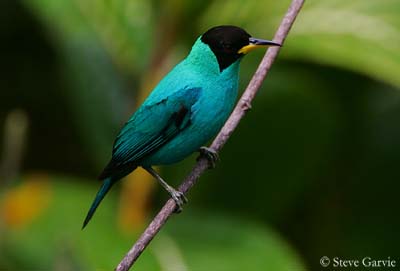
Green Honeycreeper
Chlorophanes spiza
Passeriforme Order – Thraupidae Family
BIOMETRICS:
Length: 14 cm
Weight: 17 g
DESCRIPTION:
Green Honeycreeper is a wonderful small bird with bright coloured plumage. Male and female are very different.
Adult male has bright emerald to blue-green plumage overall. Upper wings and tail are darker, with blackish edges in flight feathers and tail feathers.
Underparts are similar, but under wings and under tail feathers are blackish.
The head shows a black hood, including crown, cheeks and sides of the head, tapering into a point on neck sides. Chin and throat are bright blue-green. We can see yellow-green tinge between the black and the blue-green plumage on nape and chin.
The sharp, pointed bill is straight. It is bright yellow with black culmen. Eyes are red. Legs and feet are dark grey.
Fr: Guit-guit émeraude
All : Kappennaschvogel
Esp : Mielero Verde
Ital : Clorofane verde
Nd : Groene Suikervogel
Photographers:
Jean-Claude Billonneau
Photographe-témoin de la Beauté du Monde
Steve Garvie
RAINBIRDER Photo galleries
Text by Nicole Bouglouan
Sources:
A GUIDE TO THE BIRDS OF COLOMBIA by Steven L. Hilty and William L. Brown
Princeton University Press – ISBN 069108372X
A GUIDE TO THE BIRDS OF MEXICO AND NORTHERN CENTRAL AMERICA by Steve N. G. Howell, Sophie Webb - Oxford University Press - ISBN: 0198540124
Wikipedia (Wikipedia, The Free Encyclopedia)
Arthur Grosset's Birds (Arthur Grosset)
SORA Searchable Ornithological Research Archive (Blair O. Wolf)

Female is very different, with dull apple-green plumage overall, paler on the underparts. Flight feathers and tail are darker green. Chin and lower belly are yellowish. Bill and legs are similar to those of male, but the eyes are reddish-brown.
Juvenile resembles female but it has entirely dark grey bill and brown eyes.
VOICE: SOUNDS BY XENO-CANTO
Green Honeycreeper utters sharp “chip” as alarm call, and can repeat it several times. In flight, it gives sharp “tssip”. Its song is a soft, buzzy twittering, interspersed with brief trills.
HABITAT:
Green Honeycreeper lives in wet forests and edges, secondary woodlands, and also in clearings. It lives mainly in the canopy and it is found up to 2300 metres of elevation, but mostly below 1500 metres.
RANGE:
Green Honeycreeper lives from southern Mexico to the Amazon Basin, north-west Peru, Bolivia, south Colombia, south Venezuela and eastern Brazil.

BEHAVIOUR:
Green Honeycreeper feeds at flowering trees on nectar, but this species consumes mainly fruits and insects. It feeds in the canopy alone or in pairs, but sometimes, it may join mixed flocks.
While feeding in the canopy, it sallies to the air in order to catch insects in flight.
Green Honeycreeper forages in the canopy by hopping from twig to twig, in order to search for insects or to eat fruits.

It can be aggressive against other birds’ species at feeders.
These birds are restless and very active, but less than other honeycreepers Cyanerpes.
FLIGHT:
Green Honeycreeper performs rapid sallies to the air for catching insects.
REPRODUCTION:
Breeding season varies according to the locality, but it occurs mainly from February to August.

Green Honeycreeper nests at mid-level in trees or bushes, in a fork at about 3 to 12 metres above the ground.
Nest is a shallow cup built by female. She uses rootlets, dry leaves, fibres, and horsehair. The cup is fastened to the fork with spider webs.
She lays two white eggs with brown and grey markings. Incubation lasts about 13 days by female.
Young depend on their parents until they fledge.

DIET:
Green Honeycreeper feeds mainly on fruits, but it also drinks nectar from flowers, and catches insects and other invertebrates.
PROTECTION / THREATS / STATUS:
Green Honeycreeper is common, and this species is not threatened at this moment.
